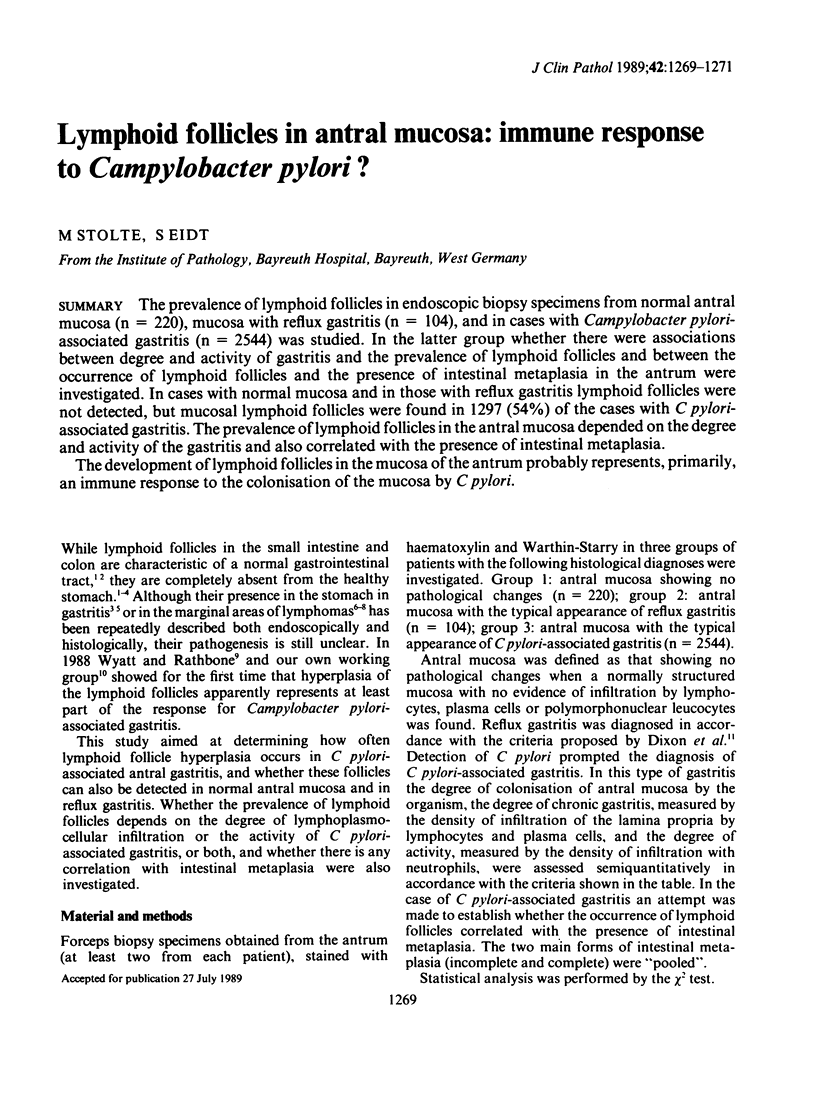Abstract
The prevalence of lymphoid follicles in endoscopic biopsy specimens from normal antral mucosa (n = 220), mucosa with reflux gastritis (n = 104), and in cases with Campylobacter pylori-associated gastritis (n = 2544) was studied. In the latter group whether there were associations between degree and activity of gastritis and the prevalence of lymphoid follicles and between the occurrence of lymphoid follicles and the presence of intestinal metaplasia in the antrum were investigated. In cases with normal mucosa and in those with reflux gastritis lymphoid follicles were not detected, but mucosal lymphoid follicles were found in 1297 (54%) of the cases with C pylori-associated gastritis. The prevalence of lymphoid follicles in the antral mucosa depended on the degree and activity of the gastritis and also correlated with the presence of intestinal metaplasia. The development of lymphoid follicles in the mucosa of the antrum probably represents, primarily, an immune response to the colonisation of the mucosa by C pylori.
Full text
PDF


Selected References
These references are in PubMed. This may not be the complete list of references from this article.
- Brooks J. J., Enterline H. T. Primary gastric lymphomas. A clinicopathologic study of 58 cases with long-term follow-up and literature review. Cancer. 1983 Feb 15;51(4):701–711. doi: 10.1002/1097-0142(19830215)51:4<701::aid-cncr2820510425>3.0.co;2-d. [DOI] [PubMed] [Google Scholar]
- Dixon M. F., O'Connor H. J., Axon A. T., King R. F., Johnston D. Reflux gastritis: distinct histopathological entity? J Clin Pathol. 1986 May;39(5):524–530. doi: 10.1136/jcp.39.5.524. [DOI] [PMC free article] [PubMed] [Google Scholar]
- Isaacson P., Wright D. H. Extranodal malignant lymphoma arising from mucosa-associated lymphoid tissue. Cancer. 1984 Jun 1;53(11):2515–2524. doi: 10.1002/1097-0142(19840601)53:11<2515::aid-cncr2820531125>3.0.co;2-c. [DOI] [PubMed] [Google Scholar]
- Moore I., Wright D. H. Primary gastric lymphoma--a tumour of mucosa-associated lymphoid tissue. A histological and immunohistochemical study of 36 cases. Histopathology. 1984 Nov;8(6):1025–1039. doi: 10.1111/j.1365-2559.1984.tb02418.x. [DOI] [PubMed] [Google Scholar]
- Ranchod M., Lewin K. J., Dorfman R. F. Lymphoid hyperplasia of the gastrointestinal tract. A study of 26 cases and review of the literature. Am J Surg Pathol. 1978 Dec;2(4):383–400. doi: 10.1097/00000478-197812000-00005. [DOI] [PubMed] [Google Scholar]
- Rösch W., Fuchs H. Diffuse lymphatische Hyperplasie, Lymphom und Pseudolymphom des Magen-Darm-Trakts. Dtsch Med Wochenschr. 1972 Jun 2;97(22):878–881. doi: 10.1055/s-0028-1107462. [DOI] [PubMed] [Google Scholar]
- Steininger H., Schneider U., Bartz K., Simmler B. Campylobacter pylori und Gastritis-Besiedelungsdichte und Grad der Entzündung. Semiquantitative und morphometrische Untersuchung. Leber Magen Darm. 1989 Mar;19(2):70–78. [PubMed] [Google Scholar]
- Stolte M., Eidt S., Ritter M., Bethke B. Campylobacter pylori und Gastritis. Assoziation oder Induktion? Pathologe. 1989 Jan;10(1):21–26. [PubMed] [Google Scholar]
- Takaki K. Lymphoid follicles appearing in gastric mucosa, especially in reactive lymphoid hyperplasia and malignant lymphoma. Acta Pathol Jpn. 1986 Nov;36(11):1627–1641. doi: 10.1111/j.1440-1827.1986.tb02227.x. [DOI] [PubMed] [Google Scholar]
- Tokunaga O., Watanabe T., Morimatsu M. Pseudolymphoma of the stomach. A clinicopathologic study of 15 cases. Cancer. 1987 Apr 1;59(7):1320–1327. doi: 10.1002/1097-0142(19870401)59:7<1320::aid-cncr2820590715>3.0.co;2-2. [DOI] [PubMed] [Google Scholar]


